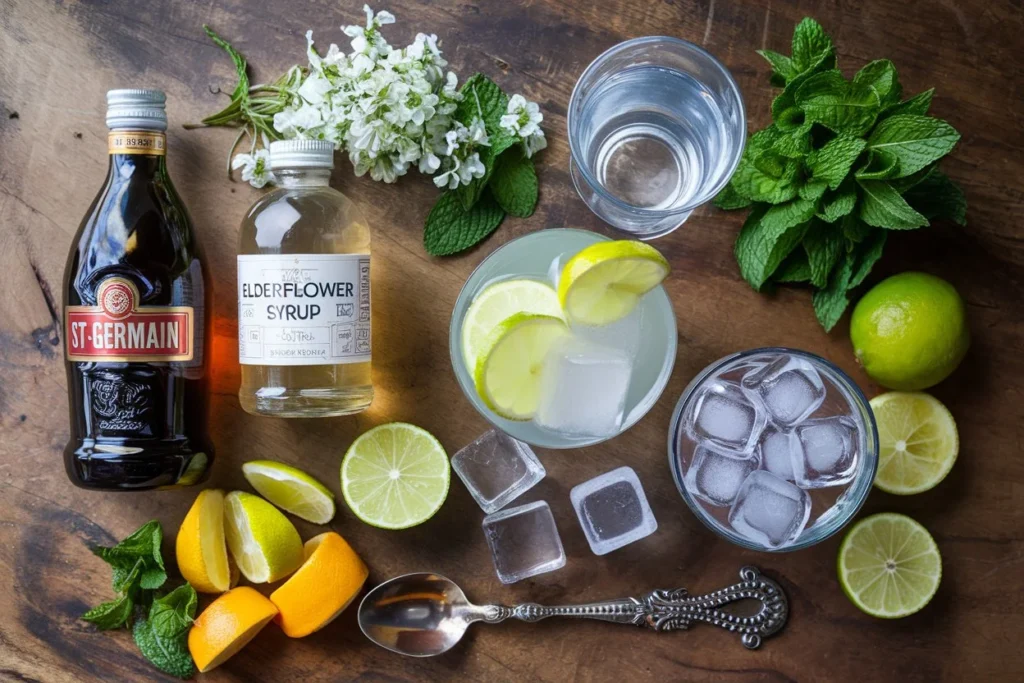When it comes to sparkling and refreshing cocktails, both the St-Germain Spritz and Hugo Spritz are popular choices. But here’s the kicker—while they might seem similar at first glance, they bring distinct flavors, ingredients, and vibes to the table. These two drinks are staples in European cocktail culture, loved for their light, aromatic nature. In this article, we’ll dive deep into their origins, ingredients, differences, and more, helping you decide which one suits your taste or occasion better. Whether you’re a cocktail aficionado or just dipping your toes into mixology, this guide will satisfy your curiosity.
Understanding the St-Germain Spritz and Hugo Spritz
What Is a St-Germain Spritz?
The St-Germain Spritz is an elegant cocktail that exudes sophistication. It features St-Germain, a delicate elderflower liqueur made from fresh blossoms, mixed with sparkling wine, soda water, and citrus garnish. This drink offers a floral, lightly sweet flavor profile that has become a favorite for aperitifs or garden parties. Originating from France, it carries a chic and modern vibe, often served in wine glasses for a refined look.
What Is a Hugo Spritz?
The Hugo Spritz, on the other hand, hails from the picturesque regions of Northern Italy. It’s a sparkling cocktail that combines elderflower syrup, Prosecco, and soda water, often garnished with mint leaves and a lime wedge. This drink is brighter and slightly herbal, with a refreshing zing perfect for warm summer days. The Hugo Spritz is a lighter, approachable choice that evokes images of Italian terraces and easy-going gatherings.
Why Are They Often Compared?
At a glance, both cocktails seem to share commonalities—sparkling wine, elderflower notes, and their refreshing nature. Yet, their distinct ingredients and preparation methods set them apart. The St-Germain Spritz emphasizes the elegance of the liqueur, while the Hugo Spritz leans into simplicity with syrup and herbs. Despite these differences, people often compare them because both offer similar vibes: breezy, aromatic, and perfect for outdoor sipping.
Origins and History
The Birth of the St-Germain Spritz
The St-Germain Spritz has an origin story as elegant as the drink itself. France introduced this cocktail in 2007, giving it its signature flavor with the launch of St-Germain liqueur. This liqueur, made from elderflowers that bloom for just a few weeks each year, was the brainchild of Robert Cooper, a third-generation distiller. Cooper aimed to capture the fleeting beauty of the elderflower in a bottle, and his efforts paid off—St-Germain liqueur quickly became a staple in upscale bars and restaurants.
The cocktail gained popularity as mixologists started pairing St-Germain liqueur with sparkling wine and soda water. Its light, floral notes complemented the bubbly effervescence of sparkling wine, making it a favorite aperitif. With its Parisian chic and universal appeal, the St-Germain Spritz soon found its way onto menus around the world, embodying sophistication in every sip.
The Emergence of the Hugo Spritz
The Hugo Spritz has a more casual yet equally captivating backstory. This refreshing cocktail originated in Northern Italy, specifically in the Südtirol (South Tyrol) region, during the early 2000s. Bartender Roland Gruber created the Hugo as an alternative to the classic Aperol Spritz, offering a gentler, floral flavor profile that is equally delightful but less bitter.
Named after a character Gruber thought up on a whim, the Hugo Spritz grew in popularity across Europe for its approachable and refreshing taste. Its use of elderflower syrup, rather than liqueur, gave it a sweeter edge, while the addition of mint and lime introduced a burst of freshness. Over the years, it became a go-to cocktail for summer afternoons, effortlessly balancing casual elegance with crowd-pleasing flavors.
Ingredients and Preparation

Key Components of a St-Germain Spritz
Creating a St-Germain Spritz is all about balance and simplicity. Here’s what goes into this chic cocktail:
- St-Germain Liqueur: The star of the show, this elderflower liqueur lends a delicate sweetness and floral aroma.
- Sparkling Wine: Bartenders typically use Prosecco or Champagne, adding bubbles and a crisp edge to balance the sweetness.
- Soda Water: A splash of soda lightens the drink, adding a refreshing effervescence.
- Garnishes: A twist of lemon or a sprig of mint enhances the visual appeal while complementing the floral notes.
To prepare, combine two parts sparkling wine, one part St-Germain liqueur, and one part soda water in a wine glass filled with ice. Gently stir, add your garnish, and voilà—an effortlessly elegant drink.
Crafting the Perfect Hugo Spritz
The Hugo Spritz is equally simple yet distinctly different in its composition:
- Elderflower Syrup: This syrup is the backbone of the Hugo, offering sweet and floral notes without the alcoholic strength of liqueur.
- Prosecco: The bubbly base brings the sparkle and lightness to this cocktail.
- Soda Water: A splash of soda balances the sweetness while enhancing the fizz.
- Mint and Lime: These garnishes aren’t just for show—they add a zesty, herbal freshness that defines the Hugo’s character.
To make a Hugo Spritz, pour a measure of elderflower syrup into a glass filled with ice. Add three parts Prosecco and one part soda water. Stir gently, garnish with a sprig of mint and a lime wedge, and enjoy!
Flavor Profiles
Tasting Notes of a St-Germain Spritz
The St-Germain Spritz offers a flavor journey that feels as sophisticated as its French origins. At its core, this cocktail is a delicate dance of floral, citrus, and sparkling notes that appeal to the senses in layers.
When you take your first sip, the elderflower liqueur greets you with its signature sweetness, reminiscent of freshly bloomed flowers. The light and refined sweetness never becomes cloying, balanced perfectly by the crisp, dry bubbles of Prosecco or Champagne. The sparkling wine introduces subtle hints of apple or pear, which blend seamlessly with the floral undertones.
The soda water adds a refreshing effervescence, creating a light, airy texture. Meanwhile, the garnish—whether it’s a twist of lemon, an orange slice, or a sprig of mint—adds an extra pop of flavor that ties the whole drink together. The result is a cocktail that is both vibrant and mellow, perfect for sipping at leisurely gatherings or upscale events.
Distinctive Flavors of a Hugo Spritz
The Hugo Spritz, in contrast, offers a more approachable and zesty flavor profile. This drink is a celebration of freshness, combining floral sweetness with herbal and citrusy highlights.
The first impression is the gentle sweetness of elderflower syrup. Unlike liqueur, the syrup’s flavor is softer and less intense, making the Hugo feel light and breezy. Prosecco brings its effervescent sparkle, offering fruity undertones that complement the syrup without overpowering it.
The magic lies in the addition of mint and lime. Mint introduces a cooling, herbal freshness that lingers on the palate, while lime provides a zesty brightness that cuts through the sweetness, ensuring the drink remains balanced. The soda water completes the experience by adding a subtle fizz that ties all the elements together. Every sip feels like a refreshing burst of summer, making the Hugo an ideal choice for warm weather or casual gatherings.
Similarities Between the Two Cocktails
Common Ingredients and Garnishes
Despite their differences, the St-Germain Spritz and Hugo Spritz share several common ingredients that contribute to their similar appeal:
- Elderflower Elements: Both cocktails feature elderflower as their main flavor. St-Germain uses elderflower liqueur, while the Hugo relies on elderflower syrup, but the floral essence is a defining characteristic of both drinks.
- Sparkling Wine: Prosecco or Champagne serves as the base, providing bubbles and a crisp, refreshing quality.
- Soda Water: A splash of soda in both drinks adds effervescence and lightens the overall flavor.
- Garnishes: Both cocktails are commonly garnished with fresh, aromatic elements. While the St-Germain often features citrus or mint, the Hugo leans towards mint and lime for its distinctive character.
These shared components create a light, effervescent profile that makes both cocktails ideal for similar occasions, such as brunches, summer parties, or elegant aperitifs.
Shared Serving Styles and Occasions
The St-Germain Spritz and Hugo Spritz share similar serving styles, and people often enjoy them in comparable settings :
- Glassware: Both are typically served in wine glasses, which showcase their sparkling, translucent beauty while allowing the garnishes to shine.
- Ice: Each cocktail is poured over ice, ensuring they remain refreshingly chilled throughout.
- Seasonality: Both are particularly popular in spring and summer when their light, floral, and refreshing qualities are most appreciated.
- Social Occasions: Both drinks are perfect for outdoor settings, like garden parties, picnics, or al fresco dining. Their effervescent nature and elegant presentation make them a natural choice for celebrations or casual gatherings alike.
In essence, the St-Germain Spritz and Hugo Spritz share a common ethos: providing a light, floral, and bubbly experience that feels both sophisticated and approachable.
Differences Between the Two Cocktails
Variations in Alcohol Content
One of the most notable differences between the St-Germain Spritz and Hugo Spritz lies in their alcohol content, which stems from their primary ingredients.
The St-Germain Spritz, with its inclusion of St-Germain liqueur, leans towards a slightly higher alcohol content. St-Germain liqueur contains about 20% alcohol by volume (ABV), and when paired with sparkling wine like Prosecco or Champagne, which usually ranges between 11-13% ABV, the result is a cocktail with moderate potency. The addition of soda water slightly dilutes the drink, but the underlying strength of the liqueur remains noticeable, giving the St-Germain Spritz a more robust kick.
In contrast, the Hugo Spritz is a lighter option in terms of alcohol content. Instead of a liqueur, it uses elderflower syrup, which is entirely non-alcoholic. This makes the drink dependent on the sparkling wine for its alcohol base, which is then balanced out by soda water. The absence of a strong alcoholic component like St-Germain liqueur ensures that the Hugo Spritz remains a gentler and more accessible choice, perfect for those who prefer a lower-alcohol cocktail.
This difference makes the St-Germain Spritz a go-to for occasions where a more spirited drink is desired, while the Hugo Spritz is ideal for easygoing, all-day sipping.
Divergence in Flavor Intensity
While both cocktails boast elderflower as their star ingredient, their flavor intensity varies significantly due to the use of syrup versus liqueur.
The St-Germain Spritz offers a more concentrated and layered flavor profile. St-Germain liqueur, being crafted from fresh elderflower blossoms, delivers a rich, floral sweetness with undertones of tropical fruits like lychee and pear. This depth of flavor is amplified by the dryness of sparkling wine, which balances the sweetness and adds a crisp edge. The result is a cocktail that feels refined, bold, and unmistakably indulgent.
The Hugo Spritz, on the other hand, is lighter and more refreshing in its flavor. The elderflower syrup provides a gentler sweetness, which is complemented by the sparkling wine’s fruity notes. The addition of mint and lime introduces herbal and citrusy elements, making the Hugo Spritz feel zippy and bright. It’s less intense than the St-Germain Spritz, leaning into its simplicity and charm rather than complexity.
Ultimately, the choice between the two comes down to preference. If you’re looking for a cocktail with bold, floral sophistication, the St-Germain Spritz is your pick. But if you’re after something fresh and breezy, the Hugo Spritz takes the crown.
Cultural Significance
The Role of St-Germain Spritz in Modern Mixology
The St-Germain Spritz has cemented its place in the modern cocktail scene as a symbol of elegance and innovation. Since its introduction, St-Germain liqueur has become a darling of mixologists, celebrated for its versatility and ability to elevate simple recipes into extraordinary drinks.
In the realm of mixology, the St-Germain Spritz embodies sophistication. It’s often featured on upscale cocktail menus, served at chic rooftop bars, and highlighted at glamorous events. Its light, floral profile makes it an ideal aperitif, and its stunning presentation—typically garnished with citrus or edible flowers—adds to its allure.
Beyond its own fame, the St-Germain Spritz has inspired countless variations and creative spins in the cocktail world. Its influence can be seen in the growing trend of elderflower-based cocktails, as well as the rise of liqueurs that blend floral and fruity notes. With its iconic status and timeless appeal, the St-Germain Spritz remains a cornerstone of contemporary mixology.
Hugo Spritz’s Popularity in European Traditions
The Hugo Spritz holds a special place in European cocktail culture, particularly in the sun-dappled terraces of Italy, Austria, and Germany. Its origins in the South Tyrol region reflect its close ties to Alpine traditions and a love for natural, refreshing flavors.
Over the years, the Hugo Spritz has become a summer staple across Europe. Its light, floral, and herbal character makes it an easy crowd-pleaser, often served at outdoor cafes, beachside bars, and family gatherings. In contrast to the St-Germain Spritz’s upscale vibe, the Hugo Spritz thrives on its simplicity and laid-back charm.
This cocktail is also deeply tied to the slow-living culture that defines many European lifestyles. Sipping a Hugo on a warm afternoon is not just about enjoying a drink; it’s about savoring the moment, connecting with friends, and embracing a relaxed pace of life. Its approachable nature and association with good times have cemented the Hugo Spritz as a beloved classic in European traditions.
Frequently Asked Questions
Is a Hugo Spritz the same as St-Germain?
No, the Hugo Spritz and the St-Germain Spritz are not the same, though they share similarities. Both cocktails use sparkling wine and feature elderflower as a primary flavor, but the key difference lies in their ingredients. The St-Germain Spritz relies on St-Germain liqueur, which has a richer, more concentrated elderflower profile and a higher alcohol content. In contrast, the Hugo Spritz uses elderflower syrup, resulting in a lighter, sweeter, and more refreshing drink with a lower alcohol content. Their flavor profiles and garnishes also differ, making them unique in their own right.
What is a good substitute for St-Germain spritz?
If you’re looking for a substitute for the St-Germain Spritz, the Hugo Spritz is an excellent alternative. While it uses elderflower syrup instead of St-Germain liqueur, it offers a similar floral sweetness and sparkling character. Other alternatives include creating a spritz with elderflower cordial, Prosecco, and soda water, or experimenting with another floral liqueur, such as Italicus or Chambord, for a different twist. Each option retains the refreshing, aromatic quality that makes the St-Germain Spritz so beloved.
What is the name of the St-Germain spritz?
The St-Germain Spritz is the official name of this elegant cocktail. However, it’s sometimes referred to simply as the “Elderflower Spritz” due to its primary flavor profile. In some circles, it might also be known by its components, such as “St-Germain Prosecco Spritz” or “Elderflower Champagne Spritz.” Regardless of the name, it’s recognized for its signature combination of St-Germain liqueur, sparkling wine, soda water, and a citrus garnish, which gives it its chic and sophisticated appeal.
What is Hugo Spritz made of?
The Hugo Spritz is a simple yet refreshing cocktail made with a handful of fresh ingredients:
- Elderflower Syrup: This provides the cocktail’s floral sweetness and sets it apart from other spritzes.
- Prosecco: The sparkling wine adds bubbles and a crisp, fruity base.
- Soda Water: A splash of soda lightens the drink and enhances its effervescence.
- Garnishes: Mint leaves and a lime wedge are added for herbal and citrusy accents.
When combined over ice in a large wine glass, these ingredients create a light, aromatic drink perfect for summer sipping or casual gatherings.
Conclusion
When comparing the St-Germain Spritz and the Hugo Spritz, it’s clear that each cocktail offers a unique experience, catering to different tastes and occasions. The St-Germain Spritz stands out with its rich, floral depth and refined elegance, making it ideal for upscale events or when you want to indulge in something sophisticated. Its use of St-Germain liqueur provides a bold, concentrated flavor that lingers on the palate.
The Hugo Spritz, on the other hand, is the epitome of freshness and simplicity. Its lighter, sweeter profile, enhanced by mint and lime, makes it perfect for warm-weather gatherings, relaxed afternoons, or when a more casual option is desired. Its lower alcohol content also makes it a more accessible choice for extended sipping.
Ultimately, the choice between these two cocktails comes down to personal preference. Whether you prefer the bold sophistication of the St-Germain Spritz or the refreshing charm of the Hugo Spritz, both drinks are sure to delight, offering a taste of European cocktail culture in every sip.


1 thought on “Is a St-Germain Spritz the Same as a Hugo Spritz? A Complete Guide”